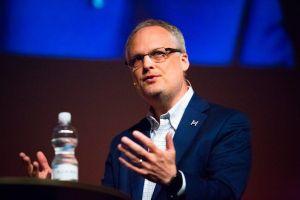An Interview: Blockchain Rival That Invented Own Decentralization
First members of the Council of 39 might be announced this summer. Beta customers will begin to build products as soon as at the end of May.

Hedera Hashgraph is a new form of distributed consensus meant to make blockchain redundant. The platform promises better speed, security and no energy-consuming Proof of Work, but it is different than what the crypto community is used to in a few ways.
First of all, it has a governing body, called the Hedera Hashgraph Council, or the Council of 39. This has raised some eyebrows, causing claims that Hedera is not truly decentralized.
Cryptonews.com talked to Mance Harmon, the co-founder and CEO of Hedera Hashgraph, about the governance, fees, speed and future plans.
Cryptonews.com: Can you tell us in layman’s terms what the difference between blockchain and hashgraph is?
Mance: Blockchain is very linear in the sense that you can only put one block on top of the chain at a time, and it’s slow because it takes a while for the community to come to agreement on which block to put on top.
Hashgraph, however, is not linear. Everything runs in parallel; any time any member of the network wants to add something to the graph, they can simply do so at their whim. The community is always coming to agreement in real time about the order of the nodes within the graph, so there’s nothing there like Proof of Work that’s normally used in blockchain to slow things down. And for those reasons, because it doesn’t use Proof of Work and it’s a graph that runs in parallel, it’s significantly faster and more performant than blockchain.
How do you respond to the community calling you centralized due to the presence of the Council?
You’re right, most people’s reaction to hearing about this is saying that it’s centralized. My immediate question back to them is, “Compared to what?”
What we have is a council of 39 members that are chosen across 18 sectors of business and from all around the world, representing all the major markets. The council membership itself is designed to reflect all the constituencies across all industries in all geographies. It’s designed to be as decentralized and council as I can imagine. When I ask, “Compared to what?” I mean that literally.
The logical answer would be “Compared to blockchain.”
Exactly, but I would not pick blockchain – compared to Bitcoin or Ethereum or EOS, pick your public network and look at its governance body, because somebody is making decisions about what changes are going into the codebase and how to run the business, etc.
Then I would say, at the scale we have achieved, we will be at least as decentralized, if not more decentralized than everything else in the market for the following reason: there are no special nodes in our network. There are no coordinators or leaders, there are no special nodes that are being proxied all of the weight of the tokens in the market. Every node in the community is the same and they’re on par with one another. All the nodes within a single shard are voting on the order of transactions within that shard, and we expect to have many hundreds or thousands of shards, each shard containing hundreds of nodes.
You mentioned the Council of 39. Could you tell us more about them, like who they are?
No. We haven’t announced their names yet, but out of the 39, we have commitments for more than half at this point. We’re in the process of working with that set to come up with a terms of governance – basically a set of policies and rules under which we’re going to operate.
We’ve given a lot of thought to what the categories of questions are that will have to be answered. Some categories of questions will simply require a 51% vote. Others will require two thirds, the majority, to approve proposals or answer questions, and some will require a unanimous vote. When we finish that process, then the existing members will come to agreement, sign contracts based on that and then we’ll make announcements about who they are. But that’s the process that we’re going through. I’m expecting that we’ll make announcements later this summer who the first batch of members are.

What are your goals in relation to Bitcoin and Ethereum, given that they’re currently industry leaders but that your product is supposedly much faster than that?
Pick your favorite social app or your favorite centralized business applications, whatever that might be; our goal is to make it possible to create the equivalent of that, but in a distributed or decentralized context to eliminate the need for those central servers. And what that has resulted in is our building a product that has performance that is orders of magnitude better and more secure than everything else is in the market.
If we can achieve that vision, the world will appreciate it and begin to build those kinds of applications on top of it. Then we’ll see where that leads us.
You mentioned security and speed as your strong points. What else is there?
In terms of security, we’ve achieved the best security possible at this algorithm level. There’s a golden standard in the field of distributed consensus for security, called asynchronous Byzantine fault tolerance, asynchronous BFT. To my knowledge, we are the only ones that have achieved it in the market today.
Performance-wise, at the same time as achieving asynchronous BFT, we achieved the best performance that one can achieve in terms of bandwidth efficiency and consensus latency. What that means practically is that we will be able to do hundreds of thousands of transactions per second, with just seconds of consensus latency, and at the same time achieve the best in security. No one else is even approaching that today.
Finally, we add another property on top of that and that is fairness. Here’s the idea: when we talk about decentralized systems, we don’t want any single party within one of these systems to have more or less influence than anybody else. We don’t want one party to prevent transactions from making it to the network or one party to dictate the order of transactions for the entire network. If they can do that, then it’s not fair.
What about prices? There are going to be fees, right?
If you want to create a platform that is going to both scale and survive, then you have to address the fundamental hard costs that exist just from running nodes in the network. So there will be fees, but we expect that the fees will be tiny in comparison to Proof of Work blockchain.
When can we expect the pricing?
We should have a notion of that later this summer. Those services I just described – cryptocurrency, smart contracts and file storage – will be completed this month. We’ll have beta customers beginning to build product using these public APIs (application programming interfaces) even as soon as the end of this month, throughout the summer. At some point in that process we will come up with standard pricing. I don’t know exactly when that will be, but that we’ll have the pricing model completed and then we expect to go version one by the end of the year.
There are projects similar to yours that promise zero fees, do they use the same underlying technology?
They’re not hashgraph, but they are a DAG. A DAG or a directed acyclic graph is a data structure that represents something. In our case, the data structure represents the gossip that has taken place across the network, or how the information is flowing across.
If you look at this data structure, in our case the hashgraph, it represents who has talked to whom and when. The picture that’s created by this data structures graph represents the gossip that’s taken place in the network. This is unique in the market – there are a bunch of different DAGs emerging and normally they represent the transactions or represent how the nodes are connected or something else. We’re unique in the fact that this represents the gossiping about gossip. That’s by definition what a hashgraph is.
Thank you for your time!
_______________
This interview has been edited for space and clarity.




